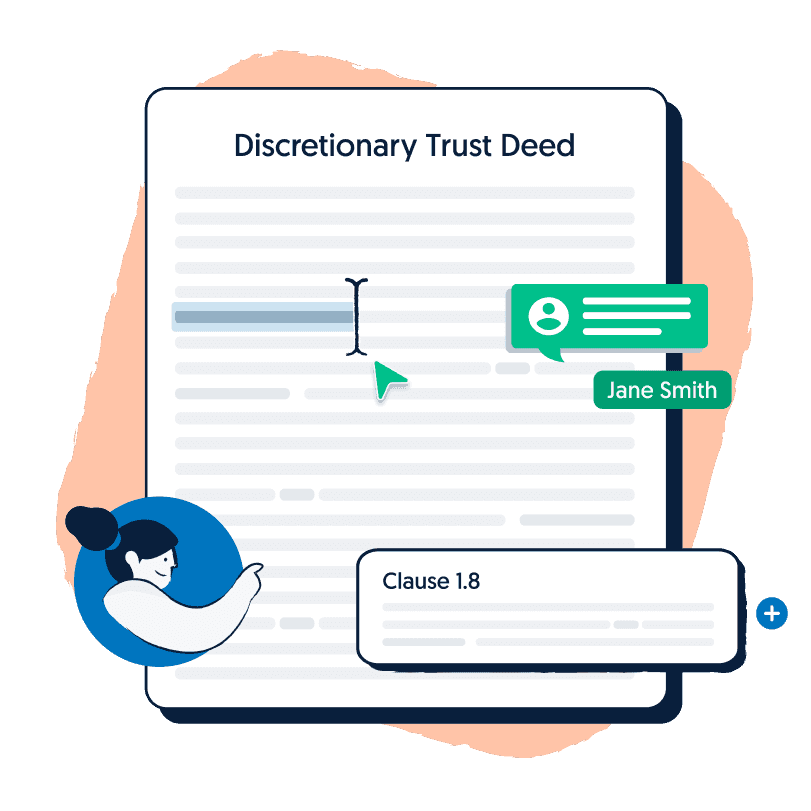Are you thinking about setting up a family trust (or a discretionary trust) in Australia but don’t know how to do it then you have come to the right place!
Setting up a family trust doesn’t need to be a complicated process if you follow the proper steps, and we’re here to help you navigate the process of a family trust setup in no time.
Table of Contents
What Is A Trust?
A trust is a legal relationship where only one party holds something for the benefit of another. Before we understand what a family trust is and how it’s set up, it’s a good idea to know what trusts generally are.
The person who holds the trust property is called the trustee, whilst those who receive the property are called beneficiaries. Trusts can be a helpful way to structure your finances, especially if you run a small business or want to distribute property to family members.
A trustee can also be a beneficiary of a trust but cannot be the only beneficiary.
What Is A Family Trust
A family trust is a type of discretionary trust created for the benefit of family members.
Through the family trust, a person (called the trustee) is under an obligation to hold property or assets for the benefit of another person or persons (the beneficiaries).
Are you wondering why it’s also referred to as a discretionary trust, or what discretion even means?
The discretion is in the trustee having the option of splitting up the trust property however they like. Discretionary power also means that the trustee:
- Can determine which beneficiaries receive the property or assets from the trust
- How much each beneficiary is to receive
- Has flexibility in distributing income and capital
Other reasons a family trust is made are:
Holding Family Assets & Asset Protection
A trust can protect the ownership of your assets while you are alive. You can transfer the legal ownership of the assets to the trust while continuing to use and enjoy them.
For example, if the family home is in a trust, you no longer personally own the house – but you could still live in it if that’s what the trust deed states.
Protecting Assets Against Claims and Creditors
Family trusts can also be used to protect selected assets against claims and creditors. For example, to protect your family home from the potential failure of a business venture.
Tax Planning and Tax Benefits
Choosing a family trust entity can allow a trustee and its beneficiaries to arrange their tax affairs to minimize their tax liability through the ATO.
The trustee decides who gets the income and capital the trust owns.
This could suit someone in the highest tax bracket with family members listed as beneficiaries at lower rates.
For example, rental income from an investment property owned by the trust could go to members of the trust on lower incomes. The same principle also applies to the taxing of dividend payments from shares owned by the trust.
Other Purposes
Family trusts are also made for the following purposes:
- To avoid challenges to a family member’s will
- This structure is set up to hold a family’s assets or conduct a family business
- Family trusts are created for the management purposes of a family business
- Family business owners (family businesses) are often set up as a trust so that each family member can be made a beneficiary without having any involvement in how the business is run
- Trusts allow parents to distribute wealth to children more precisely
- The transfer of ownership of that asset from one generation to the next in a tax-efficient way can be the difference between keeping the business in the family or being forced to sell it
- A family trust is an effective tax structure that can be used to distribute more income to beneficiaries with a lower marginal tax rate
Now that you have a good understanding of what family trusts are let’s get into the steps required to create the trust.
How To Set Up A Family Trust
Choose Your Trustees
The first question is, ‘Who will act as my trustee(s)?
The trustee of the trust will be the person or legal entity who will legally own and exercise the day-to-day control of your family trust.
For example, this person will hold the legal equitable title to a property on behalf of someone else (the beneficiary).
The decision to name a trustee can be a tricky process and involves weighing and balancing personal preferences and circumstances.
Are you wondering who a trustee can be? You can choose from
- Non-profession – A trustee can be a non-professional individual—for example, a family member
- Professional – A professional trustee can include a lawyer, accountant, or investment adviser
- Corporate trustee (trustee company) – A corporate trustee can be a bank or a corporate advisory firm
Whoever you choose to select as your trustee will need to be someone who you believe is trustworthy, reliable, and will act in the best interests of the beneficiaries.
Choose Your Beneficiaries
The next thing you need to do is to choose your beneficiaries.
Beneficiaries are the people or objects that will benefit from the trust, money, or property. In simple terms, they will have beneficial ownership of the trust assets.
Here are some essential factors to know about beneficiaries:
- Beneficiaries have a right to be considered when the trustee decides to distribute trust funds
- Beneficiaries possess a right to trust income or other trust property
- The trust deed determines the extent of the beneficiaries’ entitlement. For example, the income, property, or other
- The trust deed will determine the nature of the beneficiaries’ entitlement—for example, whether it’s a fixed amount or percentage or at the trustee’s discretion.
- The Trust deed can also define the class of person who can qualify as a beneficiary within the trust. For example, family members, corporate bodies, foreign persons etc
- While trustees have legal ownership over the trust assets, only beneficiaries have beneficial ownership
Similar to the trustee, a beneficiary can be multiple people or objectives. Let’s go through them:
- For a family trust, the beneficiaries will be a family member. For example, spouses or primary relatives such as kids
- It can be a corporate body
- Foreign persons
- Trust for a charitable purpose
Draft A Discretionary Trust Deed
The third step involves drafting a legally binding family (discretionary) trust deed for your trust to be active, which will become a binding legal document.
The purpose of a trust deed is to set out the structure and management of the family trust. Here are some things that your draft family trust should cover:
- Establishing the trust
- Defining the relevant beneficiaries
- Identifying the distribution of income and capital to the beneficiaries
- Steps to wind up the family trust
- The appointment of the trustee, including their powers and remuneration
- The removal and appointment of future trustees
- Responsibility for financial records
- A relevant indemnity
Settle the Family Trust
The fourth step involves settling your family’s trust. Why is this important? Well, settlement is the necessary legal process to establish your trust.
To ensure this is done, the settlor needs to sign the trust deed and give the trustee a nominal fee.
A settlor is an individual who will
- Sign the deed and settle the trust property
- The settlor creates the trust deed for the benefit of the beneficiaries.
- This process requires the settlor to provide a small initial sum (usually $10) to the trustee.
- A settlor is typically unrelated to the beneficiaries
- The settlor may also be someone like a close friend or someone who has no further involvement after the settlement
One other important aspect is that your settlor should not be your beneficiary of the trust itself for tax purposes.
Trustee: Sign The Deed!
The next step involves executing the deed. Here are the steps involved in this process:
- The family trust needs to be signed by the settlor
- After the trust is signed, the trustee(s) must hold a meeting agreeing on their appointment as trustee(s) of the trust
- The trustees will choose to accept and be bound by the terms of the trust deed
We recommend conducting this step in a formal setting. For example, holding the meeting in person to ensure all parties attend and witness the signing of the deed.
However, this can also happen electronically through an audiovisual link with new legislation in place.
Pay The Stamp Duty
Once the trust is established and signed, you may need to formally stamp the family trust deed.
Stamp duty differs state by state, so applications differ within states and territories. The rates below apply for trusts over non-land assets.
The costs of stamping your discretionary trust are as follows:
| New South Wales | $750 with $10 per additional stamped copy. Mailing address must be stamped by a registered OSR lodger. This stamp must also be within 3 months from the date of execution. |
| Victoria | $200 with no charge for additional copies. Mailing address must be stamped by a registered Duties Online Agent. This stamp must also be within 3 months from the date of execution. |
| Australian Capital Territory | Stamp duty is not payable or required. No time limit is imposed for stamping. |
| Queensland | Stamp duty is not payable or required. No time limit is imposed for stamping. |
| South Australia | Stamp duty is not payable or required – deeds may still be stamped “exempt” No time limit is imposed for stamping. Mailing address: Revenue SA. |
| Western Australia | Stamp duty is not payable or required. No time limit is imposed for stamping. |
| Northern Territory | $20 with $5 per additional copy. Mailing address: Commission of Taxes |
Apply for an ABN and TFN
Let’s get down to business. We are nearly to the end of the list, but upon establishing the trust, an Australian Business Number (ABN) and Tax File Number (TFN) should be made for the trust.
Open a Separate Family Trust Bank Account
We have reached the final step. Congratulations.
The final step is to open a bank account for the trust. It should be opened in the trustee’s name ‘as a trustee for the trust.’
The first deposit into the account should be the settlement sum. This sum should be there before any other deposits or transactions are made.
Frequently Asked Questions – F.A.Qs
Can a trust be a form of a business structure?
A trust can be a business structure. In this structure, a trustee can either be a company or an individual who holds the business for the beneficiaries’ advantage.
Is it worth setting up a family trust?
Setting up a family trust is a great way to hold a family’s assets, use them for estate planning, or conduct a family business.
Why would you set up a family trust?
Setting up a family trust is beneficial if you wish to protect younger beneficiaries, for example, children who may not know how to use their assets if it’s in their own name. Many individuals will choose this structure because of the Capital Gains Tax, which is advantageous compared to companies.
How much does it cost to set up a trust account?
The cost of setting up a trust account will depend on where you choose to set it up and what type of trust you choose.
For example, in NSW, under the NSW Trustee & Guardian, the one-off trust fee will be based on asset values.
Other costs involved in setting up a family trust include:
- The cost of establishing the family trust
- The cost of the deed
- The cost of the corporate trustee
- Cost of obtaining an ABN
- The costs of keeping the family trust active, lodging tax returns, GST
Can a single person set up a family trust?
Yes, a single person can set up a family trust during their lifetime to manage their assets, and investments and support beneficiaries, such as family members.
What are some benefits of setting up a family trust?
The main benefits of setting up a family trust are:
- Asset protection
- Protecting vulnerable family members such as kids
- It is tax-effective and has substantial Tax benefits
- It is favoured when there are significant investment assets involved due to their income tax
Who is a beneficiary in a trust account?
Beneficiaries are the people or objects that will benefit from the trust, money or property.
What other types of trust structures can I choose?
There are many different types of trust structures.
These include:
- Fixed unit trust
- Unit trust deed
- Bare trust deed
- Superannuation trusts
Key Takeaways
Setting up a family trust in Australia can be a smart move for asset protection, tax planning, and generational wealth transfer. By following the right steps and understanding the legal framework, you can establish a structure that benefits your family for years to come. Always consider seeking professional advice to ensure your trust is set up correctly and aligned with your long-term goals.








